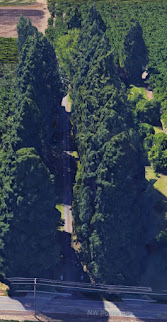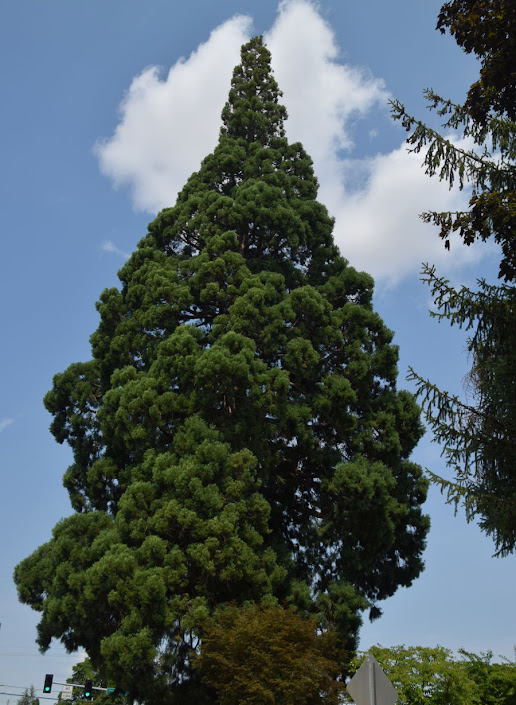Why are there so many large giant sequoias in Washington County? Clearly, these California natives didn’t grow here naturally. To solve this mystery, we will have to look back to the migration of European settlers to Oregon in the nineteenth century. John Porter was one of those immigrants. He came with his parents in 1847 and they established a farm north of Forest Grove. However, when young John heard about the California gold rush, he was off to California to make his fortune. As the saying goes, that didn’t pan out, but while traveling through the Sierra Mountains, he encountered some enormous trees. They were giant sequoias (Sequoiadendron giganteum). These trees are the largest single-stem trees in the world and among the oldest, living up to 3,000 years. It is no surprise that he was so awed by their size and beauty that he collected a large number of cones and brought them back to the farm in Oregon. He began planting the sequoia seeds that he brought back and growing giant sequoia seedlings. He started a nursery and featured the giant sequoias along with other plants. John Porter is responsible for most of the large giant sequoias now growing in Washington County, some of them now over 150 feet tall and over 150 years old. Here are a few notable ones.
 |
| View on Google Maps |
No doubt Porter Road was named after John Porter. He planted two rows of giant sequoias on the west side of the road on what must have been the location of his nursery south of Verboort. These sequoias are like a dense linear forest that stretches some 500 feet to the west. They are impressive not just for the immense size of each one, but for their number and extent as well. They are a living monument to his contribution to Washington County. It would be fitting if a large mansion stood at the west end of the trees. To find these trees, drive north from Forest Grove on Highway 47 and turn right on Porter Road. (Note: Porter Road is closed for the construction of a roundabout at Highway 47 until Sept. 30, 2023.)
The community of Verboort is less than a mile north of the Porter Road sequoias. In 1883, John Porter gave the Visitation Church at Verboort several young giant sequoias. They were planted all around the new church building that was built that year. Fire destroyed the church in 1941 but the sequoias survived, and a new church was completed at the site in 1949. The giant sequoias have grown to be great trees that dwarf the church. The smaller giant sequoias growing near the church were planted in 1974.
Governor Withycombe Sequoia
James Withycombe was the governor of Oregon from 1914 to 1919. He came to Oregon with his parents in 1871 when he was 17 years old. He purchased a farm south of Hillsboro in 1873 and married Isabel Carpenter on June 5, 1875. He planted this giant sequoia on their wedding day. You can see it growing 3 miles south of Hillsboro on the east side of Highway 219. Note the large limb on the west side that has been growing vertically and is vying to become the leader.
Pacific Avenue Sequoia
This massive giant sequoia is one for the record book. It is often listed as the largest giant sequoia in Oregon and is a State Heritage Tree. It is located at the corner of Pacific Avenue and B Street in Forest Grove. As you drive west through town on Pacific Avenue, you can see it looming over the city from several blocks away. It is one of over 100 giant sequoias towering over Forest Grove.
Hawthorne Street Sequoias
Three large giant sequoias are growing in the front yard of the Historic Hinman House at 1651 Hawthorne St. in Forest Grove. One of them rivals the size of the Pacific Avenue Sequoia and was listed as the Oregon State Champion giant sequoia by the Oregon Department of Forestry. A plaque by the door of the Hinman House shows a build date of 1876, and I suspect that the giant sequoias here were planted around then.
Courthouse Sequoias
It’s no doubt that these five giant sequoias in front of the Washington County Courthouse are the most celebrated sequoias in the County. They have a prominent location at the heart of Hillsboro at First and Main Street. They are best viewed from the south side of Main Street and tower over the Courthouse. However, they inspire the most awe when you stand underneath them and gaze up. John Porter planted these giant sequoias in 1880. They are another fitting memorial to the man who did so much to make Washington County the giant sequoia capital of Oregon.
____________________________________________
See also
Grant's Getaways: Washington County's Land of the Giants
Historic Courthouse Sequoias A Monument To John R Porter























